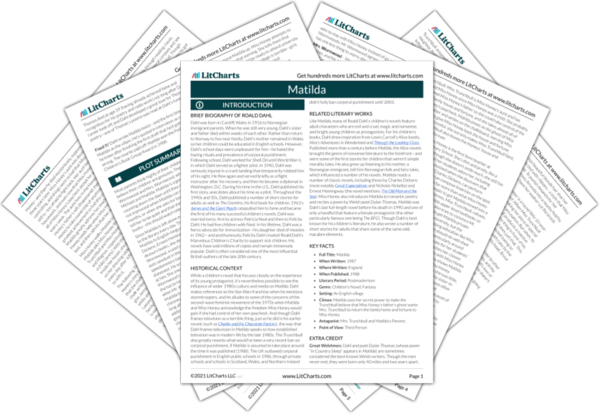Welcome to the LitCharts study guide on Roald Dahl's Matilda. Created by the original team behind SparkNotes, LitCharts are the world's best literature guides.
Matilda: Introduction
Matilda: Plot Summary
Matilda: Detailed Summary & Analysis
Matilda: Themes
Matilda: Quotes
Matilda: Characters
Matilda: Symbols
Matilda: Theme Wheel
Brief Biography of Roald Dahl

Historical Context of Matilda
Other Books Related to Matilda
Key Facts about Matilda
- Full Title: Matilda
- When Written: 1987
- Where Written: England
- When Published: 1988
- Literary Period: Postmodernism
- Genre: Children’s Novel; Fantasy
- Setting: An English village
- Climax: Matilda uses her secret power to make the Trunchbull believe that Miss Honey’s father’s ghost wants Mrs. Trunchbull to return the family home and fortune to Miss Honey.
- Antagonist: Mrs. Trunchbull and Matilda’s Parents
- Point of View: Third Person
Extra Credit for Matilda
Great Welshmen. Dahl and poet Dylan Thomas (whose poem “In Country Sleep” appears in Matilda) are sometimes considered the best-known Welsh writers. Though the men never met, they were born only 40 miles and two years apart. Thomas died at age 39 (having already achieved fame and recognition for his poetry and radio work) not long after Dahl’s career took off, and Dahl developed a great love for Thomas’s poetry—one of Thomas’s poems was read at Dahl’s funeral.
Fixed It! Dahl wrote Matilda twice—and the first time, he wrote Matilda as the villain. He’s quoted in interviews as saying that he knew after finishing the first draft that he’d gotten Matilda wrong. The rewrite paid off: Matilda won the Federation of Children’s Book Group Award in 1988.







